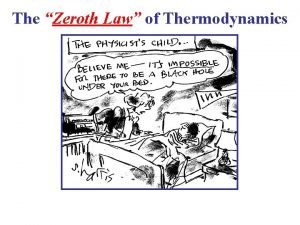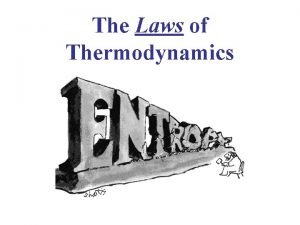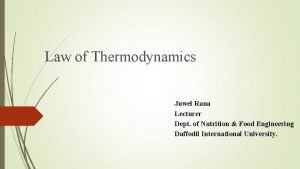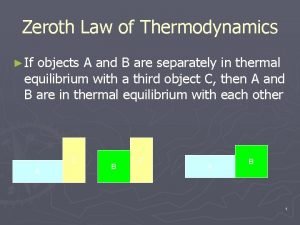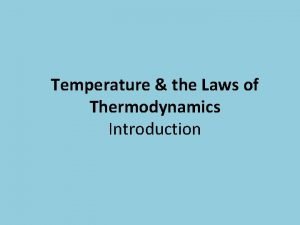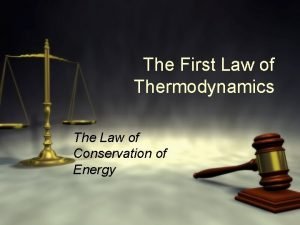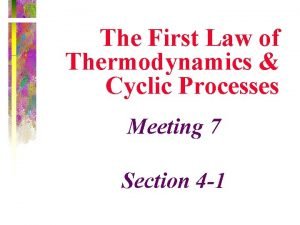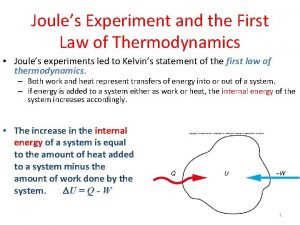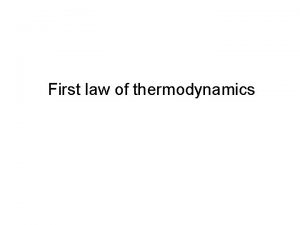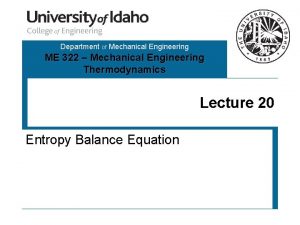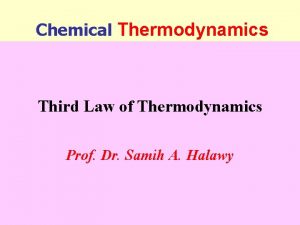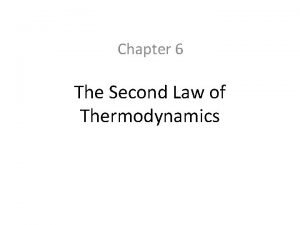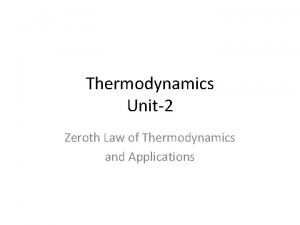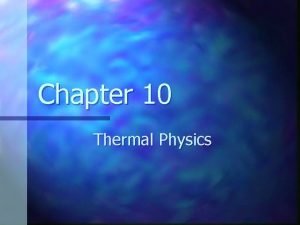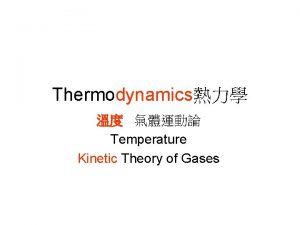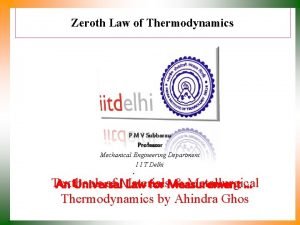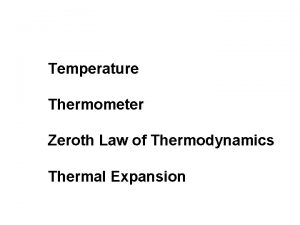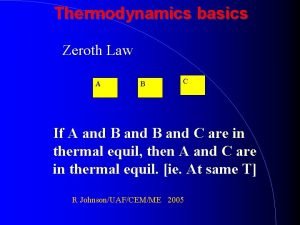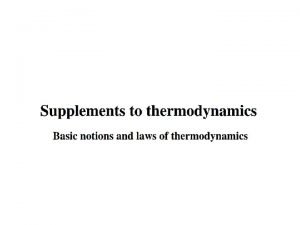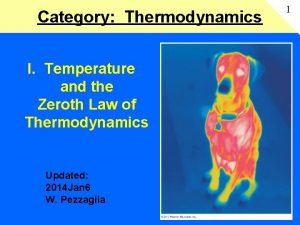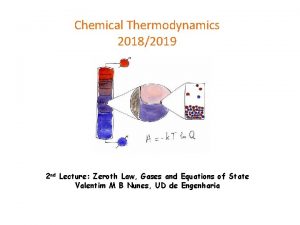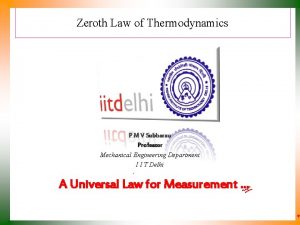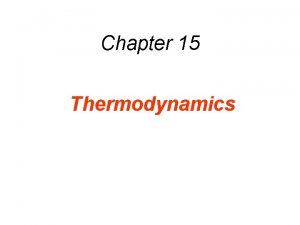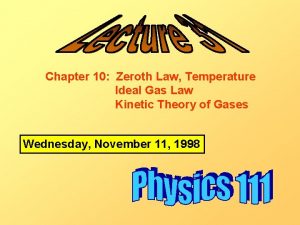Extension of Zeroth Law Thermodynamics of Measurement P

















- Slides: 17

Extension of Zeroth Law & Thermodynamics of Measurement P M V Subbarao Professor Mechanical Engineering Department I I T Delhi An Energy Transaction is Essential for Measurement of Any Parameter …

Fermi Energy • The Fermi energy, EF, is the energy associated with a particle, which is in thermal equilibrium with the system of interest. • The energy is strictly associated with the particle. • This same quantity is called the electro-chemical potential, m.

Mechanical Equilibrium When Two bodies have equality of pressure with a third body, they in turn have equality of pressure with each other. LPG Cylinder Oxygen Cylinder

Mechanical Equilibrium of A Finite size System • If a system is in mechanical equilibrium with immediate surroundings, the net force/torque is zero. • If a system is in mechanical equilibrium, there is no changing tendency for the pressure (stress) at any point. • Classification of Ammeters: • Depending on the constructing principle, there are many types of ammeter we get, they are mainly • Permanent Magnet Moving Coil (PMMC) ammeter. • Moving Iron (MI) Ammeter. • Electrodynamometer type Ammeter. • Rectifier type Ammeter.

Permanent Magnet Moving Coil (PMMC) Ammeter Deflecting torque: The torque is equal to the multiplication of force generated as per Fleming’s left hand rule with distance to the point of suspension. Deflecting Torque Generates Mechanical Inequilibrium! Where, B = Flux density in Wb/m². i = Current flowing through the coil in Amp. l = Length of the coil in m. b = Breadth of the coil in m. N = No of turns in the coil.

Permanent Magnet Moving Coil (PMMC) Ammeter : Generation of Mechanical Equilibrium Controlling Torque: This torque is produced by the spring action and opposes the deflection torque so as the pointer can come to rest at the point, where Electromagnetic torque = control spring torque. The value of control torque depends on the mechanical design of spiral springs and strip suspensions. At Mechanical Equilibrium: θ = deflection angle in radians and C = spring constant Nm /rad

Dynamic Equation for (PMMC) Ammeter At Mechanical Equilibrium: Towards Mechanical Equilibrium:

Digital Instruments & Mechanical Equilibrium Assignment 1: Develop a detailed scientific report to prove that A Digital Voltmeter used the principle of Mechanical equilibrium. Time and Date of Submission: Before 5. 00 pm, 26 Feb 2021. PDF of scanned and hand-written document.

Chemical Equilibrium A system is in chemical equilibrium when there is no tendency for the concentration of species to change. When Two bodies have equality of concentration with a third body, they in turn have equality of concentration with each other.

Thermodynamic Equilibrium • When a system is in equilibrium regarding all possible changes of state, we say that the system is in Thermodynamic Equilibrium. • The properties of a system can be measured, when system is at equilibrium. • Definition of a system using certain observable, macroscopic properties is known as description of “The state”. • Some familiar ones are temperature, pressure, and density. • How many characteristics/qualities are required to completely describe the state of a system?

State Postulate The state postulate for a simple, pure substance states that the equilibrium state can be determined by specifying any two independent intensive properties.

Change of State for A Thermodynamic System • Whenever one or more of the properties of a system change, we say that a change in state has occurred.

Engineering Economics of Change of State • Every change of state of a system consumes resource (Energy). • Detail record of a change of state is essential to efficiently use a given resource. • Keeping a record of change of state of a system is called as detailing the process in thermodynamics.

Practical Solutions to Faradys Electro. Magnetic Generator Turbo Generator Vs MHD Generator

Photo-voltaic Energy Systems

Why only Solar Radiation is used in PV Systems? ? ?

Thermoelectric Generator
 Zeroth law of thermo
Zeroth law of thermo Zeroth law of thermodynamics statement
Zeroth law of thermodynamics statement State second law of thermodynamics
State second law of thermodynamics Zeroth law of thermodynamics
Zeroth law of thermodynamics Zeroth law of thermodynamics
Zeroth law of thermodynamics Factors affecting excretion of drugs ppt
Factors affecting excretion of drugs ppt Brand extension vs line extension
Brand extension vs line extension Steady flow energy equation thermodynamics
Steady flow energy equation thermodynamics Newton's third law of thermodynamics
Newton's third law of thermodynamics First law of thermodynamics
First law of thermodynamics 1th law of thermodynamics
1th law of thermodynamics Change in entropy formula
Change in entropy formula First law of thermodynamics joule's experiment
First law of thermodynamics joule's experiment Isothermal process in thermodynamics
Isothermal process in thermodynamics Steady flow process in thermodynamics
Steady flow process in thermodynamics Second law of thermodynamics
Second law of thermodynamics Laws of thermodynamics
Laws of thermodynamics Second law of thermodynamics
Second law of thermodynamics
